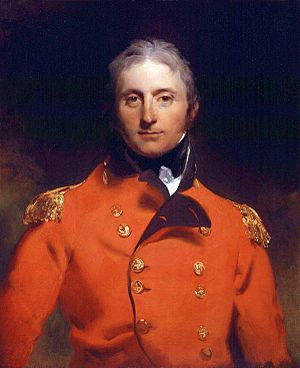Charles Pasley facts for kids
General Sir Charles William Pasley (8 September 1780 – 19 April 1861) was a British soldier and military engineer. He wrote an important book in 1810 called An Essay on the Military Policy and Institutions of the British Empire. This book changed how people in Britain thought about their empire and its place in the world.
Pasley believed Britain could not keep its empire by staying isolated. He argued that Britain would need to fight to expand its empire. He also suggested using people from the colonies as soldiers and sailors. This approach helped the British Empire grow by about 260,000 square kilometers (100,000 square miles) each year between the Battle of Waterloo and the American Civil War. During the Napoleonic Wars, Pasley served in the Royal Engineers. He was known as Europe's top expert in demolitions (blowing things up) and siege warfare (attacking castles or forts).
Contents
Early Life and Military Career
Pasley was born in Eskdale Muir, Dumfriesshire, on 8 September 1780. He was very smart, even translating the New Testament from Greek when he was only eight years old.
In 1796, he joined the Royal Military Academy at Woolwich. A year later, he became an officer in the Royal Artillery. By 1798, he moved to the Royal Engineers.
He was involved in several important military events, including the defense of Gata, the Battle of Maida, and the siege of Copenhagen. In 1807, as a captain, he went to Spain and Portugal (the Iberian Peninsula). Because he knew Spanish, he worked with important generals like Sir David Baird and Sir John Moore.
Pasley took part in the difficult retreat to Corunna. He was also part of the Walcheren Expedition, where he was badly hurt while bravely leading an attack at Flushing. While he was recovering, he used his time to learn German.
Building Military Engineering
After his active service, Pasley spent his life building a complete science of military engineering. He also worked to properly organize and train the Royal Engineers. Even though he was only a captain, he was very successful. He became the commanding royal engineer at Plymouth for two years and received a special grant.
The Peninsular War showed how much a well-trained engineer corps was needed. So, the War Office agreed with Pasley's ideas. In 1812, he was put in charge of the new Royal School of Military Engineering at Woolwich. In 1816, he became a member of the Royal Society, a famous group of scientists.
Pasley also invented a new type of pontoon bridge in 1817, which the British Army adopted. These bridges were made of two halves that could be joined. Each half was enclosed, which meant they were less likely to sink. This "Pasley Pontoon" was used until 1836.
He was promoted to major in 1813 and lieutenant-colonel in 1814. He wrote several important books, including Military Instruction (starting in 1814), which covered geometry and how to build fortifications. He also published Practical Architecture and a major book called The Practical Operations of a Siege (1829–1832), which was even translated into French.
Later Contributions
Pasley continued to be promoted, becoming a colonel in 1830. From 1831 to 1834, he worked on making coins, weights, and measures the same across the country. He published a book about this in 1834.
In 1838, the city of London honored him for his work. He had successfully removed sunken ships from the bottom of the Thames River near Gravesend. From 1839 to 1844, he was busy clearing the wrecks of two famous ships, HMS Royal George from Spithead and HMS Edgar from St. Helens. All these projects helped him develop the art of military engineering.
Railway Inspectorate
On 23 November 1841, Pasley was promoted to major-general and became an inspector-general of railways. This was a time when many new railway lines were being built. He inspected many of these new lines. He often criticized how quickly some lines were opened, saying they had poor engineering standards.
However, he faced criticism himself for approving the North British Railway's line from Edinburgh to Berwick in June 1846. Heavy rain in September 1846 caused the bridges and earthworks to fail, making nineteen miles of track unusable. Temporary repairs were made, and Pasley approved them. But some of the new work also proved faulty.
In November 1846, the railway inspectorate was reorganized, and Pasley did not get a new position. He was then made a Knight Commander of the Order of the Bath (K.C.B.). After this, he mainly worked with the East India Company's military school at Addiscombe. He was promoted to lieutenant-general in 1851 and general in 1860.
Pasley died in London on 19 April 1861. His oldest son, Major-General Charles Pasley (1824–1890), also became a distinguished Royal Engineer officer.
Cement Research
In 1826, while teaching at the Royal School of Military Engineering at Chatham, Pasley started researching and experimenting with artificial hydraulic cement. He wanted to create a cement that was as good as or better than natural "Roman cement" invented by James Parker in 1796.
In 1830, he succeeded. Using chalk and clay from the Medway River, he made a hydraulic lime. This cement was similar to the natural "Roman" cement and also like the cement made by Joseph Aspdin in Wakefield.
Works
Besides the books mentioned earlier, Pasley also wrote:
- Practical Geometry Method (1822)
- Course of Elementary Fortification (1822)
- Rules for Escalading Fortifications not having Palisaded Covered Ways (1822)
- Descriptions of a semaphore (a signaling device) he invented in 1804 (1822 and 1823)
- A Simple Practical Treatise on Field Fortification (1823)
- Exercise of the Newdecked Pontoons invented by Lieutenant-Colonel Pasley (1823)
Links to Works
- Essay on the Military Policy and institutions of the British Empire by Charles Pasley (2nd ed., 1811): Part I
See also
- Dee bridge disaster
- Penmanshiel Tunnel
- Railway Inspectorate
Images for kids




